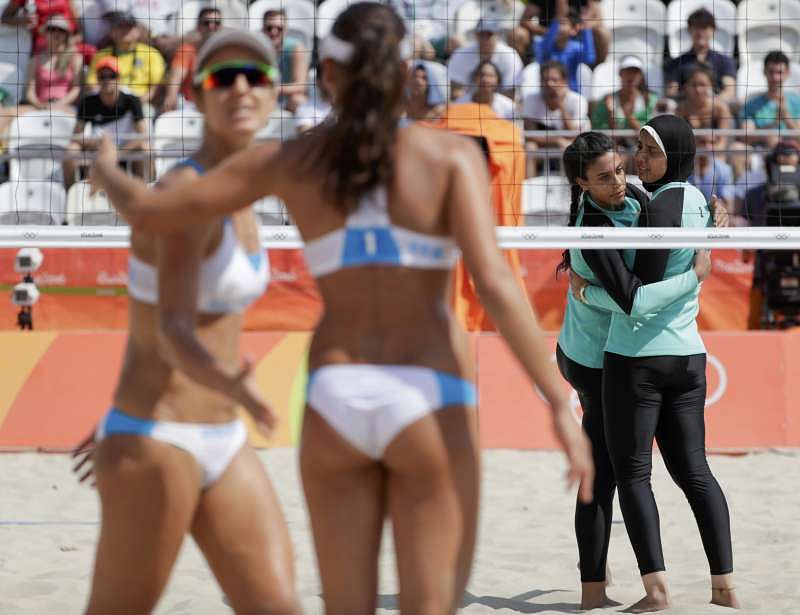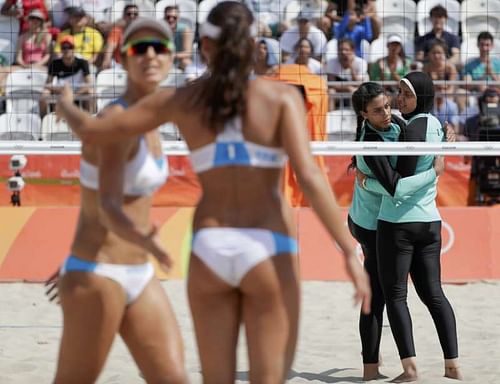
Beach Volleyball - Male pros look overdressed on skimpy Copacabana

By Stephen Eisenhammer
RIO DE JANEIRO (Reuters) - On a hot Rio morning under a perfect sky, the sand flies as a bare body dives for a dig. This isn't the Olympic arena, but the public volleyball nets of Copacabana beach and here the men proudly wear tiny swim shorts known in Brazil as "sungas."
"They're more comfortable, it's what we wear to the beach," said Renato Bastos, a 67-year-old retired Rio resident warming up before a match. "I can go for a swim straight after a game, have a beer while I dry off, it's great."
For a sport often described as the Olympic's sexiest, the men competing at the temporary 12,000-seat arena on Copacabana can appear strangely overdressed in baggy tank tops and long board shorts against their female counterparts in bikinis.
The sparsely dressed locals of Copacabana make them look more formal still.
"It's a complete joke isn't it," said Brazil female volleyball star Agatha Bednarczuk, after beating Argentina in a pool match, a cheeky smile gleaming down from her 1.82 meter frame. "They should play in sungas."
More than any other sport at the Olympics, beach volleyball attracts attention because of what players wear. Many criticise the sport's apparent objectification of women, arguing that the sculpted athletes in their tiny attire are used to increase popularity.
This week, outfits went viral on social media once again, with people sharing pictures of Egypt's Doaa Elghobashy in a hijab going up for a block against Germany's Kira Walkenhorst in a bikini.
The contrast was seen by some as evidence of the unifying affect of the Games. For others it showed the freedom of the West against female oppression in parts of Islamic culture.
Czech Republic's Anouk Verge-Depre said the photo put to bed the notion that women are forced to wear tiny uniforms by sponsors or broadcasters. "We wear what we like," she said.
So why not the men? She shrugged: "I'd like to see the men play without shirts."
Why they don't is mainly down to sponsors, according to the International Volleyball Federation (FIVB).
"It's something we've seriously considered, but right now for financial reasons we can't do it," said Angelo Squeo, FIVB director for beach volleyball. "The promoters want the men to wear tops because they need space for sponsors and they've already got hardly any space with the girls."
On the U.S. beach volleyball circuit men play topless and in casual matches on beaches around the world they do too. When the men train, away from the cameras, Squeo admits they often play without a shirt.
For Cheryl Cooky, a sociologist at Purdue University in Indiana who studies the portrayal of female and male athletes in the media, the issue touches on the broader dominance of male stakeholders at the top of sporting federations, broadcasters and sponsors.
"The decision-makers are men and men don't want to see men without their shirts on unless they're gay," she said, explaining that persistent homophobia makes many men uncomfortable with the objectification of the male body.
Squeo disagrees. In the future, when money is less tight, he said FIVB would happily let men go bare-chested.
But what about sungas?
"No, no, no," said Brazilian gold medal favourite Alison Cerutti. "We could take off our tops, but sunga no... sunga, no."
(Reporting by Stephen Eisenhammer, editing by Susanna Twidale)